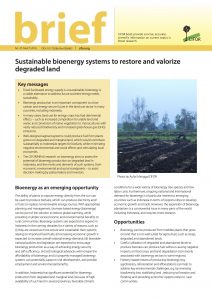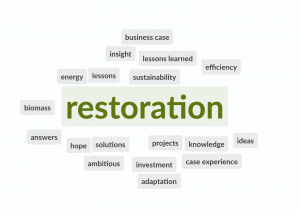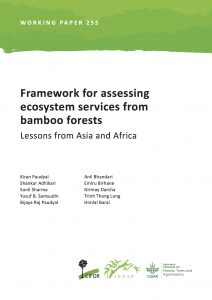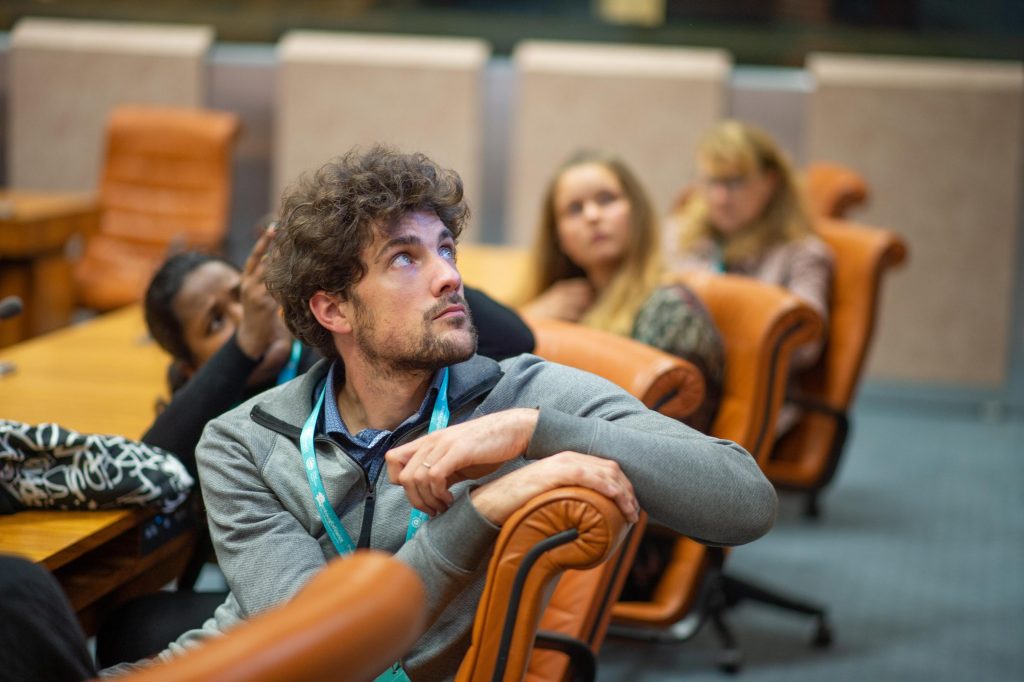Indonesia bets on biomass to power local economies
Indonesia is committed to supplying energy to all of its people, but with 260 million citizens scattered across 17,500 islands, this is no small ambition.

The archipelago has more than 24 million hectares of degraded lands. Hence, replanting and restoring these areas through community-based programs and using part of the biomass to produce bioenergy could boost local economies while contributing to global climate goals.
The panel ‘Restoration of degraded land for bioenergy and rural livelihoods: a promising business case from Indonesia’ looked into new business models convening communities, authorities and the private sector to power remote rural villages in the world’s largest archipelago.
The event was co-organized by the Indonesia Ministry of National Development Planning (BAPPENAS), the Global Green Growth Institute (GGGI), the Centre for International Forestry Research (CIFOR), and the Forests, Trees and Agroforestry (FTA) research program of the CGIAR.

The audience was treated to a lively and interactive session with live polls that allowed the panel to gain insight on the collective feeling on particular issues. At the very beginning the collective expectations on the session converged on one topic: restoration.
A further set of questions were posed to the audience during the course of the session expanding the dialogue between audience and panel. In particular, attendees indicated that in order for the bioenergy developments to benefit smallholders and rural communities, energy needs to be affordable and accessible to them. Interestingly, capacity building was identified by the audience as the most important safeguard for coupling the bioenergy transition with landscape restoration. Finally, with a surprising twist, the audience did not fully agree that in general coal transition to biomass is the dominant pathway with respect to the development of other renewables. However, it was deemed extremely important, especially in cases like the one discussed by the panelists.
Ending the poverty-energy trap
For 50 million Indonesians in off-grid rural communities, energy bills are 10 to 20 times higher than in cities due to the steep cost of kerosene lamps and diesel-generators. Higher bills add to the existing poverty-energy trap, where the poorest people are less likely to have access to power, and without it, they are more likely to remain poor.
“This is also the case for people in Mentawai Islands, a world-class surfer destination off the West of Sumatra with thousands of visitors per year,” explained panelist Maria Wahono. She is president commissioner of Clean Power Indonesia (CPI), a private developer that, in 2018, sealed a 20-year agreement with a state-owned utility company and communities to provide three villages in Mentawai with bioenergy.
As part of the project, Indonesian authorities supported communities to establish 300 hectares of bamboo forest in degraded or underutilized lands, and people now sell this biomass to CPI’s power plant.
The facility transforms the bamboo into combustible gas and provides 1,300 homes with power at a subsidized tariff, allowing communities to realize income from selling bamboo after paying electricity bills. In addition, the plant employs 150 people.
“For this type of biomass energy project to be commercially feasible and replicable across the country, we need three separate investments: a state-owned utility company that provides the network distribution and off-taker guarantee to de-risk the investment; the regional government or ministries responsible for promoting biomass supply, including bamboo farming activities; and private actors that focus exclusively on power plant development,” explained Wahono.
The Mentawai energy project set up the first bamboo-based biomass power plant in Asia-Pacific, and now wants to spread to more than 40 villages, advancing national plans to reach a bioenergy capacity of 500 MW in the next five years.
Just as importantly, the lessons learned from this project are informing biomass initiatives elsewhere, pointed out Ingvild Solvang, Sustainability and Safeguards Manager with GGGI –an intergovernmental organization that helps governments’ transition into green growth economic models.
Sustainable business models
GGGI is currently scoping a business model in West Timor that mirrors the project in Mentawai. “We are building on each other’s work and showing that ‘collaboration is the new competition’,” said Solvang.
In the new model, the state company would also be tasked with ensuring a reliable supply of biomass into the 2.2 MW power plant, and the project could generate USD 1 million in revenues for communities. “In Eastern Indonesia this is sorely needed because livelihoods are the number one priority for people and the government,” said the panelist.
The plant is set to create jobs and to power local enterprises, which are instrumental to sustain demand in the long term. For Solvang, “the use of electricity for productive purposes is essential to ensure a viable and sustainable business model, and to fuel local economic development.”
Wahono pointed out the importance of using tropical bamboo as a sustainable biomass option, instead of some preferred alternatives in other areas of Indonesia. This grass is native to most islands in the archipelago; it can grow up to two meters per week; its plantations are inexpensive to maintain, and it is culturally appropriate.

A framework for assessing a wider variety of ecosystem services deriving from bamboo forests was recently jointly published by CIFOR and INBAR, two FTA partners.
Panelists reiterated that potential benefits of renewable energies are many-fold, and that well thought-out bioenergy models offer opportunities on various fronts: baseload electricity production, job creation, land restoration for biodiversity and production purposes, as well as the fight against climate change.
This is why GGGI is also conducting broader assessments on the opportunities for green jobs creation under Indonesia’s commitments to the global climate agenda, known as nationally determined contributions (NDCs).
“Policy-makers need to balance the short-term need to create jobs with longer-term climate targets that may appear more abstract,” said Solvang. “By providing figures on the social and economic co-benefits of climate action, we can create political and social demand for it.”

Political support
In Indonesia, the expansion of sustainable bioenergy models is encouraged by the national Low Carbon Development framework, as explained by the BAPPENAS Director of Energy Resources, Minerals and Mining, Dr. Yahya Rachmana Hidayat.
The country’s plans seek a boost in energy efficiency in the next five years, as well as a 30 per cent increase in the production of electricity from renewable energy sources by 2040.
“There are huge opportunities lying ahead of us: our current installed capacity of renewable energies amounts to less than 3 percent of its potential, which we estimate at 420 GW,” said the Director.
“We have developed a five-year strategy to develop energy plantation forests, and we seek to increase the contribution of the bioenergy industry to the national economy,” added Yahya, noting the willingness of the Ministry of Environment and Forestry and that of Energy and Restoration to work closer together.
Restoring landscapes
Indonesia’s policy framework envisages the creation of energy forests and the use of organic waste from various industries. The same approach is adopted for a new biomass energy and restoration project to be implemented in Lampung, Southern Sumatra.
The objective of the project, which is in the design stage, is to convert an existing inland coalfired power plant to run on biomass fuel. Up to 40 percent of the biomass will be supplied by community-based forestry and agricultural activities, and the rest will come from an agreement with a state-owned plantation of rubber, palm oil and sugar cane meant to ensure security of supply.
“Central Lampung has been intensively cultivated for over one hundred years and has many degraded lands, hence the restoration approach,” said Michael Brady, CIFOR principal scientist and team leader for Value Chains and Finance. “All three commodities have been there for a long time, so there is also a lot of over-mature rubber and palm oil waste the plant can use.”
Several panelists highlighted the need to adopt appropriate safeguards and to address governance issues ahead of project implementation, as emphasized by George Winkel, Head of the Bonn Office and Governance Programme at the European Forest Institute (EFI).
“There is a pressing need to ensure coordination across land use sectors and different levels of governance, so projects stay connected to the interests of local communities,” said the expert.
For example, provisions should be taken to ensure energy plantations do not jeopardize food security, lead to displacement, or lock communities into disadvantageous business deals.
Hence, Winkel called for land use planning that convenes all relevant stakeholders around the use that should be given to degraded lands, and noted the importance of clarifying legal frameworks and land tenure rights before embarking on any restoration and bioenergy initiative.
“A possibility is connecting restoration and bioenergy projects with ongoing FLEGT and REDD+ initiatives, many of which are already working on the relevant governance issues,” he pointed out.
Solvang from GGGI also encouraged cooperation between the bioenergy initiatives themselves to reach many more people: “We are building on each other, and we will hopefully come up with projects that can be bundled together and presented as interesting opportunities for investors.”
Collaboration was a red thread running through all the panelists interventions. A prerequisite to design and implement sustainable bioenergy ventures on a large scale with a view to healing landscapes while improving livelihoods. To this end, all of the panelists plan to be involved in the new biomass project at Lampung, which is entering the feasibility assessment stage.
By the FTA Communication Team.
This article was produced by the CGIAR Research Program on Forests, Trees and Agroforestry (FTA). The event at GLF Luxembourg was co-funded by the National Institute of Forest Science (NIFoS) of the Republic of Korea.
FTA is the world’s largest research for development program to enhance the role of forests, trees and agroforestry in sustainable development and food security and to address climate change. CIFOR leads FTA in partnership with Bioversity International, CATIE, CIRAD, INBAR, ICRAF and TBI. FTA’s work is supported by the CGIAR Trust Fund.











